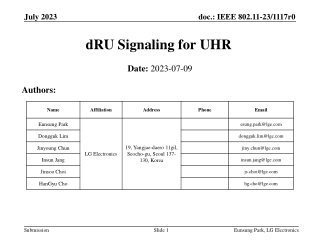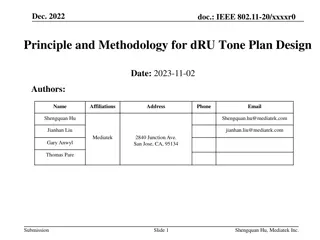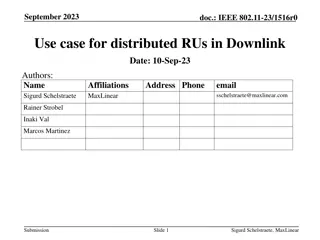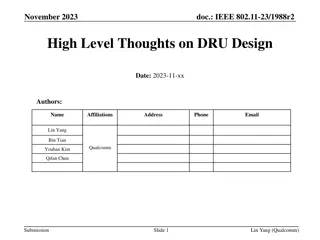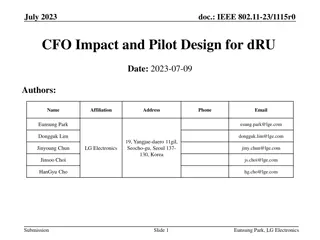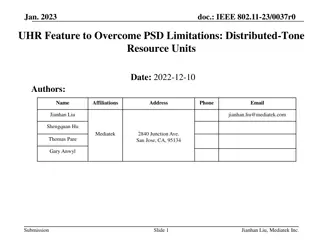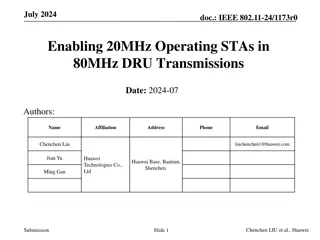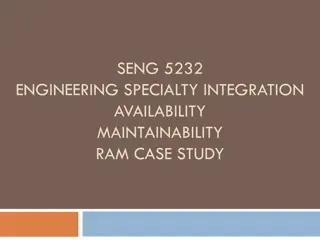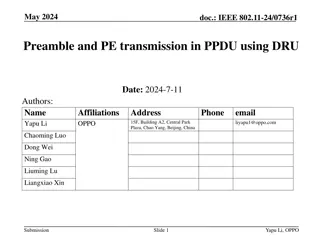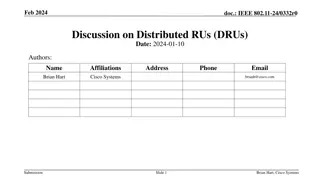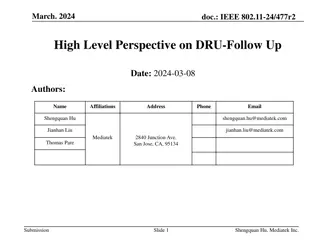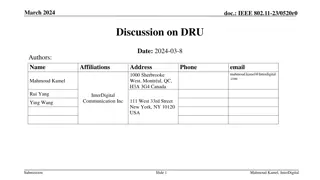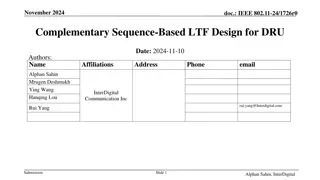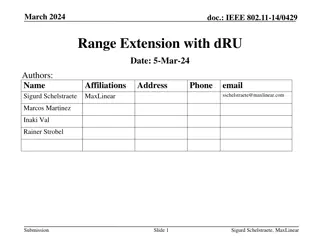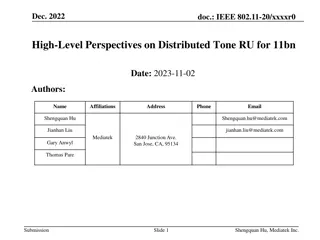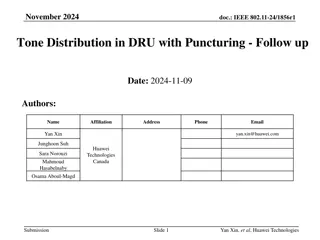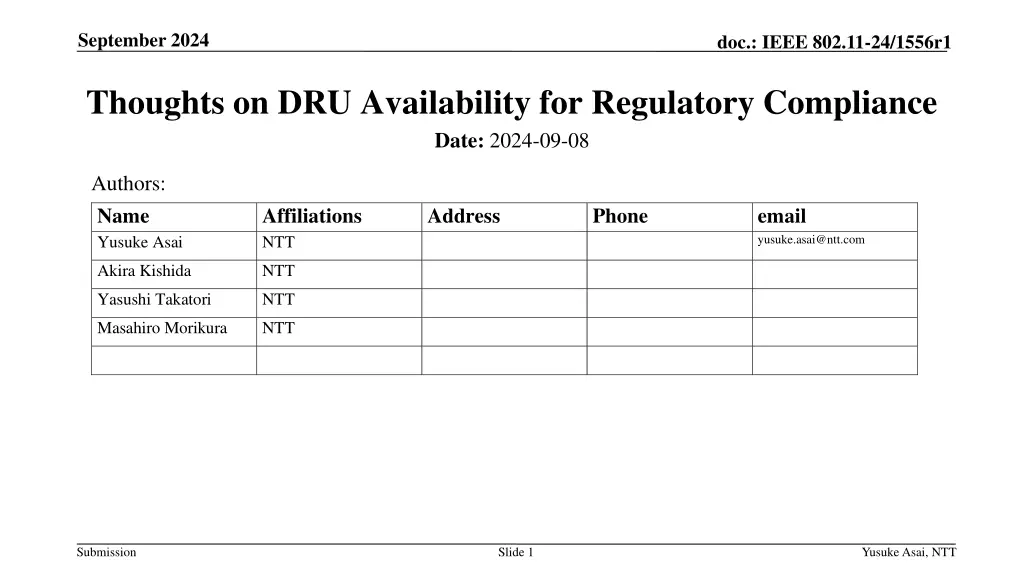
DRU Availability for Regulatory Compliance in Japanese 5/6 GHz Bands
Explore the implications of Dynamic Frequency Selection (DRU) for regulatory compliance in the context of Japanese regulations pertaining to the 5/6 GHz bands. Delve into the challenges and proposed solutions for aligning DRU patterns with Japanese subcarrier density requirements, ensuring a compliant and efficient WLAN system.
Download Presentation

Please find below an Image/Link to download the presentation.
The content on the website is provided AS IS for your information and personal use only. It may not be sold, licensed, or shared on other websites without obtaining consent from the author. If you encounter any issues during the download, it is possible that the publisher has removed the file from their server.
You are allowed to download the files provided on this website for personal or commercial use, subject to the condition that they are used lawfully. All files are the property of their respective owners.
The content on the website is provided AS IS for your information and personal use only. It may not be sold, licensed, or shared on other websites without obtaining consent from the author.
E N D
Presentation Transcript
September 2024 doc.: IEEE 802.11-24/1556r1 Thoughts on DRU Availability for Regulatory Compliance Date: 2024-09-08 Authors: Name Yusuke Asai Affiliations NTT Address Phone email yusuke.asai@ntt.com Akira Kishida NTT Yasushi Takatori NTT Masahiro Morikura NTT Submission Slide 1 Yusuke Asai, NTT
September 2024 doc.: IEEE 802.11-24/1556r1 Abstract DRU is one of the most important features in 11bn because it greatly improves rate vs range performance. There are many submission regarding DRU and some of features have already been approved to include the SFD [1]. On the other hand, some submissions [2][3] have raised concern about regulatory compliance with DRU, and thus TGbn should be careful about availability of DRU. This submission discusses on DRU availability compliant with Japanese regulation as a case study. Some restrictions for DRU patterns should be needed and propose a solution. Submission Slide 2 Yusuke Asai, NTT
September 2024 doc.: IEEE 802.11-24/1556r1 Case Study: Japanese Regulation for 5/6 GHz bands The regulatory rules for Japanese 5/6 GHz bands (i.e. 5150-5350MHz, 5470-5730 MHz, 5925-6425 MHz) are based on the rules for 5.2 GHz band (i.e. 5150-5250 MHz) which was opened in the year of 2000. The rules for the 5.2 GHz band are generally dedicated for IEEE 802.11a and ETSI HIPERLAN/2, which are high-speed wireless local access systems. The following rules are typical examples. The number of subcarriers per 1 MHz is equal to or more than one in OFDM transmissions. The center frequencies and channel bandwidth sets (20/40/80/160/80+80/320 MHz) are identical to the baseline of IEEE 802.11. In 40 MHz or wider bandwidth transmission, the available modulation scheme is OFDM only. Energy based carrier sense mechanisms (similar to CCA-ED) is a mandatory function. Submission Slide 3 Yusuke Asai, NTT
September 2024 doc.: IEEE 802.11-24/1556r1 Case Study: Japanese Regulation for 5/6 GHz bands (Cont d) The aim of these rules is to exclude low-rate systems such as frequency hopping and narrowband systems, for fully utilizing the potential of the broadband wireless access. Therefore, such narrowband systems cannot obtain type approvals of Japan. Those rules makes the Japanese 5/6 GHz bands clean (no narrowband interference), and thus it is beneficial for the WLAN system from the users perspective and should be preserved in the future. Submission Slide 4 Yusuke Asai, NTT
September 2024 doc.: IEEE 802.11-24/1556r1 Case Study: Problem Statement DRU mechanisms allocate subcarriers sparser than those in RRU. It makes the occupied bandwidth of DRU larger than that of RRU. Some patterns of DRU do not satisfy with the Japanese regulatory rules The number of subcarriers per 1 MHz is equal to or more than one in OFDM transmissions. n_sc sum of n_sc Bw [MHz] n_sc: DRU pattern Bw: bandwidth of DRU When (sum of n_sc)/Bw < 1, the subcarrier density is too sparse and labelled as NG . 20 40 80 160 320 26 26 OK NG NG NG NG 52 52 OK OK NG NG NG * When n_sc is 484+242 or more, any valid bandwidth satisfy with the rule. 52+26 78 OK OK NG NG NG 106 106 OK OK OK NG NG 106+26 132 OK OK OK NG NG ** There is no room for applying the subcarrier allocation by DRU manner. 242 242 Invalid** OK OK OK NG 484 484 - Invalid** OK OK OK Submission Slide 5 Yusuke Asai, NTT
September 2024 doc.: IEEE 802.11-24/1556r1 Discussions This case study shows just an example but 11bn should prepare for additional restrictions of DRU usage for compliance with regulatory rules in various regulatory domains (including Japan). Even when some of DRU variation cannot be used, we can still have some power boost effect, and thus to maximize the availability of DRU makes greatly sense. DRU is used for UL OFDMA transmissions and each STA uses a DRU pattern that is signaled by a trigger frame. If an AP knows the DRU patterns with NG in advance, it simply avoids to use them, and thus the problem is completely resolved. An STA never select the DRUs with NG as far as a trigger frame does not set them; therefore, there is no need to add a rule for restrictions at STA side. Slide 6 Submission Yusuke Asai, NTT
September 2024 doc.: IEEE 802.11-24/1556r1 Possible Solution One of the possible solutions is to define the OK/NG table for DRU (as described on the previous slide) in each regulatory domain in Annex D and to define the restriction rules on the normative texts of DRU operation section. Many WLAN products are based on globally common platform, and they are applied some customization for compliance with each regulatory domain. If the 11bn amendment is designed assuming DRU restriction in advance, implementors can prepare and 11bn products will easily implement it, which will lead to cost reduction in terms of local customization (e.g., the cost for obtaining type approval). Submission Slide 7 Yusuke Asai, NTT
September 2024 doc.: IEEE 802.11-24/1556r1 Conclusions It is crucial to follow regulatory rules when DRU is used. In addition, maximizing the availability of DRU is also important. As a case study, we have reviewed the relation between DRU patters and Japanese regulatory rules, which showed some patterns of DRUs do not match with Japanese regulatory rules. The availability of DRU depends on the regulatory rules. To resolve this, 11bn should define to restrict DRU patterns according to the regulatory domain. It can be done by restricting the DRU variations in AP side only. It has the merit for cost reduction in terms of local customization. Submission Slide 8 Yusuke Asai, NTT
September 2024 doc.: IEEE 802.11-24/1556r1 Straw Poll Do you agree that the 11bn should define a mechanism to restrict DRU patterns for maximizing the availability as far as compliant with the regulatory rule in each regulatory domain? Y-N-A: Submission Slide 9 Yusuke Asai, NTT
September 2024 doc.: IEEE 802.11-24/1556r1 References [1] Ross Jian Yu, Specification Framework for TGbn, 11-24/0209r4. [2] Brian Hart, Discussion on Distributed RUs (DRUs), 11-24/0332r0. [3] Yusuke Asai, et. al., Thoughts on DRU Availability, 11-24/0882r2, May 2024. [4] The rules for radio equipment (in Japanese) https://laws.e-gov.go.jp/law/325M50080000018 Submission Slide 10 Yusuke Asai, NTT

